Are you a Quiet Speculation member?
If not, now is a perfect time to join up! Our powerful tools, breaking-news analysis, and exclusive Discord channel will make sure you stay up to date and ahead of the curve.
Another event, another set of data, another reexamination of the Modern metagame. As the time of actual Modern Opens and Grand Prix approaches, Modern players are increasingly seeking to find the new rules for the format and whatever edge they can. I'll be tracking those changes as the data comes in, looking for developments and indications of where the metagame is heading.
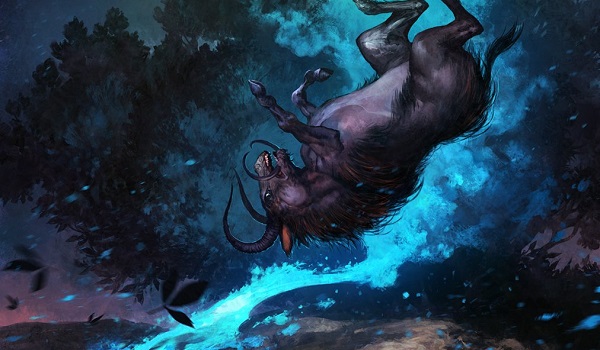
SCG Indy Classic
The first thing is to update the metagame data. So long as Star City continues to have events, there will be Modern Classics to examine. I'm reasonably certain that SCG events aren't great indications of the overall metagame since their population is fairly insular. That said, SCG is the most prolific creator of reliable paper results. Thus, I intend to use the latest Classic to examine how the SCG meta has changed since the bannings. I'll be looking at how generally applicable they are later on.
| Deck Name | Total # |
|---|---|
| Amulet Titan | 2 |
| Mono-Red Prowess | 2 |
| Jund | 1 |
| Jund Death's Shadow | 1 |
| Grixis Whirza Breach | 1 |
| Heliod Company | 1 |
| Selesnya Titan | 1 |
| Titanshift | 1 |
| Burn | 1 |
| Devoted Devastation | 1 |
| Bant Snowblade | 1 |
| The Rock | 1 |
| Simic Titan | 1 |
| Dimir Whirza | 1 |
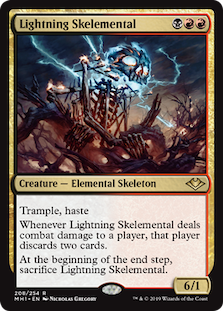 The first thing I want to do is ask if anyone knows Michael Bischoff so they can ask about his deck. Right now SCG is listing Lightning Elemental in his decklist, and I can't believe that's correct. Lightning Skelemental I'd believe, but the question remains why he's running it in the first place (assuming that's the correct card). Skelemental isn't a bad card by itself, and coupled with An Unearthly Child, can be a plan. However, three mana is a lot for a gameplan that emphasizes peak efficiency via mana maximization and card power. Even if I look at Skelemental as fodder for Kroxa, Titan of Death's Hunger, it's still not particularly efficient. It obviously worked, but I'd like to know why.
The first thing I want to do is ask if anyone knows Michael Bischoff so they can ask about his deck. Right now SCG is listing Lightning Elemental in his decklist, and I can't believe that's correct. Lightning Skelemental I'd believe, but the question remains why he's running it in the first place (assuming that's the correct card). Skelemental isn't a bad card by itself, and coupled with An Unearthly Child, can be a plan. However, three mana is a lot for a gameplan that emphasizes peak efficiency via mana maximization and card power. Even if I look at Skelemental as fodder for Kroxa, Titan of Death's Hunger, it's still not particularly efficient. It obviously worked, but I'd like to know why.
Secondly, it should be noted that a fairly standard Jund list actually won the Open. Never underestimate the power of power. I say "fairly standard" because the Kroxas are a recent addition. I'm skeptical, since graveyard hate was already effective against Jund, and unless Kroxa escapes it's just a worse Raven's Crime. However, Reid Duke thinks otherwise, and I'd never recommend my word over his on a question of Jund.
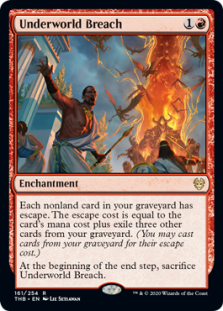 The final deck I want to highlight is the third-place Grixis Urza Breach deck. As we've seen in previous data sets, Urza decks are returning as a force now that pilots have stopped mourning Mox Opal. I knew the ban wouldn't kill Urza. However, I did expect it to kill the Underworld Breach/Grinding Station, combo since there was no reliable mana generator anymore. Ryan Bennett found work arounds.
The final deck I want to highlight is the third-place Grixis Urza Breach deck. As we've seen in previous data sets, Urza decks are returning as a force now that pilots have stopped mourning Mox Opal. I knew the ban wouldn't kill Urza. However, I did expect it to kill the Underworld Breach/Grinding Station, combo since there was no reliable mana generator anymore. Ryan Bennett found work arounds.
With an Urza or Emry in play, Mox Amber works just as well during the combo, letting Ryan mill his deck out and win with Thassa's Oracle. Alternatively, he can use Sly Requisitioner to generate the tokens he needs to feed the station to mill out his opponents instead. It looks a little clunky and I suspect Ryan got a lot of value from opponents being confused, but this is a deck to watch.
Titan Rising?
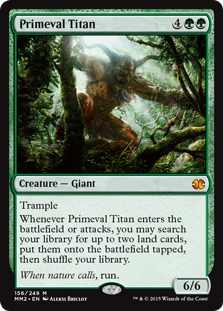 There are a lot of Primeval Titan decks in this data: two Amulet Titan decks, two Amulet-less Titan decks, and then Titan Shift. Given the previously established hype surrounding Titan as the best deck in Modern and its relative lack of showing in previous Classics, this development could be seen as a prophecy at last fulfilled.
There are a lot of Primeval Titan decks in this data: two Amulet Titan decks, two Amulet-less Titan decks, and then Titan Shift. Given the previously established hype surrounding Titan as the best deck in Modern and its relative lack of showing in previous Classics, this development could be seen as a prophecy at last fulfilled.
I wouldn't go so far. This is the first data point with lots of Titan results. It could easily be a fluke. Indeed, Titan Shift has randomly appeared in results regardless of positioning for as long as we've been tracking event data. That it made top 16 here doesn't mean anything in light of that history. It's just That Deck that sometimes does well, and is not a reflection on the other Titan decks.
Furthermore, there are confounding factors with this data. With only 8 rounds, the Classic was more like a large PTQ, so there's more chance for local distortions to happen. Additionally, the SCG team events have all been overrun by Titan players, despite their mediocre overall performance. Since Indy was a Pioneer Open, it wouldn't surprise me if a lot of Amulet players attended just for the Modern Classic, so the starting population could have been higher. If Classics continue to have high amounts of Titan decks, that could be indicative. As of right now, don't get excited.
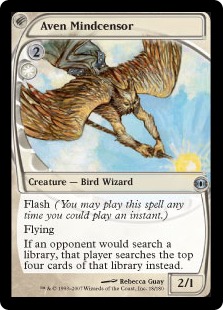 There's also a lot of variation between the Titan decks, possibly explaining how they maneuvered through the tournament. While all five decks are running the same general core of Primeval Titan, Dryad of the Ilysian Grove, Sakura-Tribe Elder, Once Upon a Time, and Summoner's Pact, they're positioning themselves very differently. The Amulet decks are sideboarding more like combo decks, with lots of defensive measures and anti-hate cards. The Amulet-Less decks have more cards against the mirror and become land-value decks. Titan Shift packs more sweepers and hate cards, indicating that it's trending towards midrange. The varying approaches indicate that the pilots were prepared for metagame attacks and were able to correctly respond rather than smash through. Successful adaptation is not a sign of being overpowered.
There's also a lot of variation between the Titan decks, possibly explaining how they maneuvered through the tournament. While all five decks are running the same general core of Primeval Titan, Dryad of the Ilysian Grove, Sakura-Tribe Elder, Once Upon a Time, and Summoner's Pact, they're positioning themselves very differently. The Amulet decks are sideboarding more like combo decks, with lots of defensive measures and anti-hate cards. The Amulet-Less decks have more cards against the mirror and become land-value decks. Titan Shift packs more sweepers and hate cards, indicating that it's trending towards midrange. The varying approaches indicate that the pilots were prepared for metagame attacks and were able to correctly respond rather than smash through. Successful adaptation is not a sign of being overpowered.
Metagame Adjustments
The other notable change is an absence: Mono-Red Prowess is down by half compared to the previous two Classics. Amulet Titan is also down compared to the Richmond Classic, but it's up relative to Philadelphia.
I'm not surprised that Prowess fell off. Right after the bannings, I noted that red decks are always strong at the start of a new metagame, but they also always peter out. They're solid choices regardless of the metagame, but after a major shakeup, are particularly well-positioned.
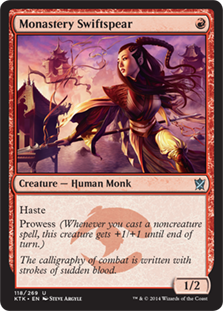 When the metagame is being redefined, red decks are particularly strong thanks to their simplistic, concentrated approach. Everyone else is trying to figure out what they're doing and what they care about, and red decks just go for the face. As the metagame settles, the inefficiencies in other decks diminish, and the relative advantage of red's simple plan erodes. It's not that their power or positioning has weakened in absolute terms, but rather that other decks are catching up. Given its cheap price, I'd expect Prowess to remain a factor in Modern, but it will move out of the limelight and become one of the pack.
When the metagame is being redefined, red decks are particularly strong thanks to their simplistic, concentrated approach. Everyone else is trying to figure out what they're doing and what they care about, and red decks just go for the face. As the metagame settles, the inefficiencies in other decks diminish, and the relative advantage of red's simple plan erodes. It's not that their power or positioning has weakened in absolute terms, but rather that other decks are catching up. Given its cheap price, I'd expect Prowess to remain a factor in Modern, but it will move out of the limelight and become one of the pack.
Speaking of which, the metagame underneath Prowess and Titan has shown no sign of settling. The composition of the many singleton decks in each SCG Classic is constantly shifting, indicating a very open metagame. The only consistent presences are Dimir Whirza and Heliod Company. The former is down from its initial position, but keeps making Top 16. I'm not surprised, I knew that deck would adapt and thrive despite the ban. Whether 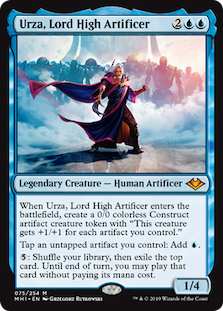 Urza's wall of text alone is enough to keep the deck top-tier remains to be seen, but it's making a compelling argument. Company's position also makes sense. It's a deck of many combos that plays a lot of tutors. In a linear format, it can find the right combo for the right situation. With players focused on Titan and Prowess, the spot removal that tears the deck apart isn't seeing enough play.
Urza's wall of text alone is enough to keep the deck top-tier remains to be seen, but it's making a compelling argument. Company's position also makes sense. It's a deck of many combos that plays a lot of tutors. In a linear format, it can find the right combo for the right situation. With players focused on Titan and Prowess, the spot removal that tears the deck apart isn't seeing enough play.
The fact that Prowess and Titan continue to headline Classic results makes a strong case for them being top-tier decks. The consistency of Company and Whirza is suggestive of promise, but not really indicative. We need more data. As for the rest of the format, the only thing I can conclude is that it remains wide open. There are a lot of strong decks in Modern, but for the most part, they're not that much stronger than any other. Knowing your deck and having a good sideboard remain the deciding factors.
Metagame Adaptation
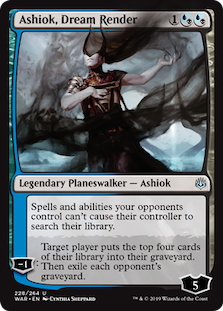 In a more general sense, what the Indianapolis SCG Classic results indicate is that the metagame has absorbed the recent shockwaves from the bannings and is adapting to the presumptive best decks. Much like the MCM Paris results, the Indy Classic's decklists reveal that players are more than aware of Amulet Titan's reputation, but they're ready. Ashiok, Dream Render is in most sideboards, and Aether Gust is also a frequent include. The former is solid against Titan itself, though not the best since can still win through Ashiok if it draws the payoff lands. The later is useful not only in buying a turn before Titan hits, but in removing Dryad in response to Valakut triggers. Interestingly, the Titan decks are running the most anti-Titan cards, clearly anticipating a Titan-heavy metagame. Based on the data I have, it looks like overkill, but again SCG has been unnaturally Titan-heavy so far. At least Gust isn't terrible against red decks, so the space isn't completely wasted.
In a more general sense, what the Indianapolis SCG Classic results indicate is that the metagame has absorbed the recent shockwaves from the bannings and is adapting to the presumptive best decks. Much like the MCM Paris results, the Indy Classic's decklists reveal that players are more than aware of Amulet Titan's reputation, but they're ready. Ashiok, Dream Render is in most sideboards, and Aether Gust is also a frequent include. The former is solid against Titan itself, though not the best since can still win through Ashiok if it draws the payoff lands. The later is useful not only in buying a turn before Titan hits, but in removing Dryad in response to Valakut triggers. Interestingly, the Titan decks are running the most anti-Titan cards, clearly anticipating a Titan-heavy metagame. Based on the data I have, it looks like overkill, but again SCG has been unnaturally Titan-heavy so far. At least Gust isn't terrible against red decks, so the space isn't completely wasted.
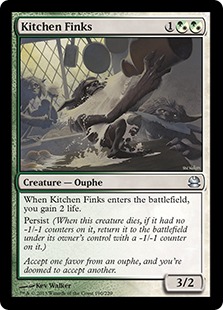 After Titan, the next target is Prowess. There are a lot of Kitchen Finks and Collective Brutalitys in this Classic. Neither are the best anti-Prowess cards, but they do work, and are helping keep Prowess's numbers down. In fact, the presence of all the hate and depressed numbers of the targeted decks suggests that the hate is working, providing a strong argument that the metagame is simply acclimating to its new equilibrium state. The metagame is too broad for specialized hate, so players are sticking to broader cards. To me, this can only mean that the metagame is healthy, and once the adjustment period is through Titan and Prowess will just be part of the scenery. They'll be more prominent decks, certainly, but not necessarily oppressive.
After Titan, the next target is Prowess. There are a lot of Kitchen Finks and Collective Brutalitys in this Classic. Neither are the best anti-Prowess cards, but they do work, and are helping keep Prowess's numbers down. In fact, the presence of all the hate and depressed numbers of the targeted decks suggests that the hate is working, providing a strong argument that the metagame is simply acclimating to its new equilibrium state. The metagame is too broad for specialized hate, so players are sticking to broader cards. To me, this can only mean that the metagame is healthy, and once the adjustment period is through Titan and Prowess will just be part of the scenery. They'll be more prominent decks, certainly, but not necessarily oppressive.
Alternative View
Of course, that may only apply to the SCG Tour. I need more varied data to actually predict the metagame. Unfortunately, I couldn't find any big Modern events from this past weekend to compare, but I can use the online meta again. As with my first investigation, I'm drawing on the data from MTGGoldfish and MTGTop8, since they're doing all the work aggregating all the MTGO events.
I did encounter an issue with the timescale. MTGTop8's more reliable data is their two-month horizon, which at this time includes pre-banning results. They haven't updated the Decks to Beat for February, so I'm going with the data for the past two weeks, as it's free of Oko. It's also worth noting that Top8 likes to amalgamate similar decks under one banner. Goldfish's data doesn't appear to include Oko, though I'm not certain how far back it actually goes. In any case, I'm using them together as a comparison against the observed SCG metagame rather than looking at them in a vacuum.
Since both sites list too many decks to do a full ranking, I set cutoff points for their top decks. Due to the nature of their data, Top8's was 6% and Goldfish's was 3%.
| MTGTop8 Top Decks | Metagame % | MTGGoldfish Top Decks | Metagame % |
|---|---|---|---|
| Death's Shadow | 13 | Amulet Titan | 7.39 |
| Amulet Titan | 12 | Mono-Red Prowess | 6.37 |
| Creature's Toolbox | 7% | Jund | 4.75 |
| Red Deck Wins | 7 | Eldrazi Tron | 3.82 |
| Jund | 7 | Dimir Whirza | 3.57 |
| Humans | 6 | Bant Snowblade | 3.48 |
| Urza | 6 |
What all three sources agree on is that Amulet Titan is a popular deck. However, it's relative positioning is not clear. SCG and Goldfish give it a narrow lead over other decks, where Top8 has it well ahead of its rivals but behind Death's Shadow variants. Prowess is middle of the 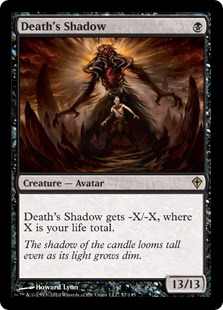 pack in Top8 (and would be lower without Burn's help) where it's second elsewhere. Part of this is definitely Top8's aggregations, but more generally, it backs up the narrative that has emerged from the actual data I've worked with. Prowess and Amulet Titan are the presumptive best decks, but if they are at all it's not by that much. Modern is well on its way to adapting and normalizing both, and there's no indication of an unhealthy metagame.
pack in Top8 (and would be lower without Burn's help) where it's second elsewhere. Part of this is definitely Top8's aggregations, but more generally, it backs up the narrative that has emerged from the actual data I've worked with. Prowess and Amulet Titan are the presumptive best decks, but if they are at all it's not by that much. Modern is well on its way to adapting and normalizing both, and there's no indication of an unhealthy metagame.
The only caveat is the consistent Titan core I mentioned above. It's present throughout the online data too, and the same core being used in multiple decks and in different metagame positions is a potential problem. There's no justification in the data for doing so, but Wizards has made bans in the past for diversity's sake. I suspect that if they do, Once will be the target, as free spells are more bannable than the alternatives. However, again, I wouldn't expect that to happen for some time if at all.
Metagame Maturity
The increasing adoption of common cards within maindeck strategies typically indicates a metagame maturing. The wild brewing period is over, and the technological chaff is being separated from the wheat. Further, the early front-runners are beginning to fall off as everyone else catches up and adapts. That the overall format looks quite healthy bodes well for the an enjoyable GP and Open season. Though, of course, more data may change my conclusions.




Hey David,
Thanks for the insights, as always Modern Nexus is still among the strongest sources of objective analysis that I know of. My meta has seen a pretty substantial increase of Infect decks to combat the Titanic menace. The common consensus among the infect players I’ve spoken to, in and around Chicago, seems to be that infect has decent match ups, not only against Titan decks, but against the meta broadly. Where do you see that deck going in the next few months?
Infect has long been a solid meta call. As long as targeted removal is low, which seems to be the case right now, it will steal games.
With Jund and Stoneblade making their presence known, I wouldn’t go as far as your players, but if you need something to embarrass Titan, it’s quite good. I’d be cautious taking it to a big event simply because red decks tend to be hard matchups and depending on the build Infect can lose to Blood Moon.